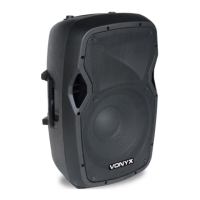REAR PANEL
1. Jack ¼” input connector for microphone.
2. RCA line input connector for the audio input source e.g.
mixer, CD player, etc.
3. Volume control for the microphone.
4. Volume control for the line input.
5. Tone control.
6. Power ON/OFF LED indicator. This clear green indicator
will light when the amplifier is turned on.
Passive speaker output connector, minimum load 8 Ohm!
TROUBLESHOOTING
One certain method of determining if a speaker is faulty is to substitute a speaker that is known to work correctly for
the suspected problem speaker. If the “normally correct speaker” is experiencing the same difficulties or problems
as the suspected problem speaker, use the information below to isolate the problem.
Substitute known good cables
Check solder joins
Inspect cable for damage
Inspect wire or connector for stray strand that may short
While it is possible for a faulty speaker to exhibit intermittent
output, it’s more likely that an output cable/connector is the
problem. Check the soldering on your connectors.
Constant noise,
buzzing and/or
humming
Any constant noise originates in the amplifier, mixer, signal
processing, source device in the signal devices, or line-level
wiring. Check and correct system grounding as required. Chain
check for noisy sources or electronic components. Check wiring
for shielding.
Poor low-
frequency output
When two speakers in close proximity to each other are
connected out-of-polarity, they can partially cancel each other out,
especially at low frequencies. Check your speaker cables to be
sure they are all identically wired and connected. Check the
balanced line signal cables to be sure they are all correctly wired.

